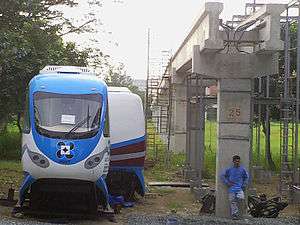University of the Philippines Diliman Automated Guideway Transit System
| University of the Philippines Diliman Automated Guideway Transit System | |
|---|---|
|
UP Diliman AGT System | |
| Overview | |
| Type | Automated Guideway Transit (AGT) |
| Status | Under construction |
| Locale |
|
| Stations | 13 (planned) [1] |
| Services | University campus loop (planned) |
| Technical | |
| Track length |
465 meters (1,526 ft) (test track) 6.9 kilometers (4.3 mi) (planned)[2] |
| Number of tracks | 1 |
| Operating speed | 50–60 kilometers per hour (31–37 mph) (planned) |
The University of the Philippines Diliman AGT[1] is an automated guideway transit (AGT) system currently under construction and development within the campus of the University of the Philippines in Diliman, Quezon City in the Philippines. It will serve as test track for the first mass transit system to be built and developed in the country by local engineers.[3]
The first phase of the project is funded by the Department of Science and Technology (DOST) in a joint project with the administration of the University of the Philippines. DOST provided funding and supervised the first phase as well as the design of the coaches and track to be used. If found feasible, the project would be expanded into a 6.9-kilometre (4.3 mi) intracampus loop.[2] Building the AGT is not viewed as a replacement for the jeepneys that ply the campus in a loop, but as a supplement as it travels on a different route.[4]
Despite some media reports calling it a monorail, the system uses two parallel concrete beams to form a track.
History
In his speech during his 2011 State of the Nation, President Benigno Aquino III called for the development of the AGT elevated train system as a potential solution to the problem of mass transportation in country. The project could result in more kilometers of cheap transport, decongesting urban centers and allowing rural communities easier access to centers of commerce and industry.[5] Based on international studies, the AGT system is the most cost-effective and less intrusive mass transport for commuting countries like the Philippines according to DOST. AGT systems are designed to be cheaper and lighter than the rapid transit system serving the commuters of Metro Manila. The system would be developed and built locally utilizing local engineers and resources to minimize cost.[6]
Plans for the rapid transit system were revealed as early as December 2010. The electric, driverless, fully automated guideway transit system would be grade-separated, running on rubber tires. DOST assured that it will not harm the environment and no trees will be cut in the campus. The train will have two passenger coaches with a capacity of 60 persons per coach.[6]
The construction of the railway was started in June after the contract was awarded to construction and engineering firm Miescor Builders Inc.[3] The groundbreaking ceremony was held on July 18, 2011 at the corner of Jacinto St. and Lakandula St.[6] The trains with two coaches arrived at the campus on November 25, 2012 with the initial test run scheduled in December 2012.[4] The initial test track is 465-metre (1,526 ft) long with an elevation of 6.1-metre (20 ft),[3] between C.P. Garcia Avenue, across from the Commission on Higher Education building, and Jacinto Street running along the College of Fine Arts.[5]
Both the DOST and the university will conduct test runs to check economic viability, power consumption and strength of materials.[2] The test track will be also be used to fine-tune the technology's mechanisms and operation, which include speed, stability, brake distance, and power, among others.[5] DOST previously created an earlier prototype, launched in Bicutan, Taguig City on a straight 150-metre (490 ft) track. The UPD campus is a chance to test the system on a curved and circular track.[2]
The budget of the Department of Science and Technology for the elevated track and the AGT train was initially placed at PHP 16 million and PHP 4 million, respectively.[6] The amount of the contract awarded to Miescor is PHP 22 million.[3] The trains cost less as they are locally made using local materials, not imported.[4]
Aquino and various government officials rode the test line in April 2013; the ride was described as "bumpy" because of uneven tracks and the suspension system. Officials from the DOST said that in the next generation of vehicles these problems would be rectified.[7]
Future plans
With the success of the first phase of the project, the future is completing the 6.9-kilometre (4.3 mi) track that will loop the campus. The route will include stops not covered by jeepneys. A total of thirteen stations are included in the proposed plan.[5]
The pilot AGT project will serve as a test case for future cheaper and safer alternative for mass transit projects in the country.[6] The speed of the train in the campus is planned at 50 to 60 kilometers per hour (31 to 37 mph) similar to MRT-3 trains, but an upgrade to 120 kilometers per hour (75 mph) is under study.[6]
References
- 1 2 "UP AGT map". Caught (up) in traffic. Retrieved on 2012-12-11.
- 1 2 3 4 Regidor, Anna Kristine. "UPD monorail project begins". 2011-07-27. University of the Philippines Diliman. Retrieved 2012-11-08.
- 1 2 3 4 Patria, Kim Arveen (2012-11-26). "New UP monorail coaches arrive". Yahoo News. Retrieved on 2012-12-11.
- 1 2 3 Lapeña, Carmela G. (2012-11-27). "Test run of UP-Diliman mass transit system set next week". Yahoo-GMA News. Retrieved on 2012-12-11.
- 1 2 3 4 Rappler.com (2012-11-25). "UP Monorail: 'Ikot' jeeps of the future arrive at UP Diliman". Science.ph. Retrieved on 2012-12-12.
- 1 2 3 4 5 6 Valmero, Anna. "DoST to develop electric-powered monorail for mass transport".
- ↑ "After bumpy ride, Noy wants UP train fixed". Philippines Star. April 30, 2013.
External links
Coordinates: 14°39′11.03″N 121°3′34.92″E / 14.6530639°N 121.0597000°E

